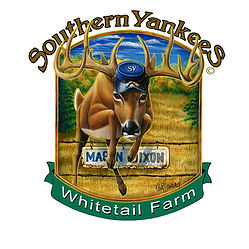


When you know you want big body typicals, go where you know they live!


Yankee Reckoning- 2018

Yankee Thor
Yankee Tripwire
BUCKS


Yankee Rumor - 2018
Yankee Insidious
Yankee 2-year old buck racing to be the first out of velvet.


ROMAN, AUSTIN & W21


FAWNS & DOES

YANKEE PEACHES
AUSTIN & YANKEE'S GHOST

UNCLE DAVID & FURY


JAMES &
YANKEE'S GHOST

AUSTIN FEEDING YANKEE'S GHOST
ELI FEEDING ELLIE

ELI, UNCLE DAVID & YANKEE KELLY

ELI FEEDING
A DOE FAWN

ABOUT US
Why the name Southern Yankees? Well, it has nothing to do with our family heritage because my wife and I were born and raised here in north Alabama, not north of the Mason-Dixon. But………our whitetail deer, on the other hand, are full blooded Yankees lucky enough to be raised in the south; hence the farm name of Southern Yankees.
My wife, Belinda, and I have been raising whitetail deer for over 30 years. It started as a hobby before there was much of an industry. In the beginning we had a couple of native deer but we soon realized that it was taking too long to grow big bucks with our southern genetics. So, we started looking for some bigger genetics and after some research realized that the northern genetics had what we were looking for. We got rid of all our southern genetics and went “Yankee”. The northern strain of deer were born earlier (late May instead of July and August). This allowed enough time for the fawns to mature before fall which meant about 50% of the does were bred by one of the buck fawns from that same year. Never before did we have buck fawns with hard white buttons and ready to breed at 7 months old. Their body sizes were almost twice the size of our native southern deer. As the northern deer got older we knew we were onto something with antler scores on 2 year old that had taken 4 or 5 years to grow with our southern genetics.
Our children, Christopher and Mandy were just little kids during the early years of our raising deer. They ran the gamut of emotions as to how they felt about the deer farm. Initially they couldn’t get enough, then the years of bottle feeding finally took its toll. But as young adults they once again love being involved from time to time. They both help when handling the deer in the barn as well as dressing it up for a little PR at the trade shows and auctions.
So, it’s been a family affair that has been focused on growing fast maturing typical whitetail deer who survive. Our yearling bucks range from 120”-170” and two year old from 180”-220” while maintaining a very typical look. Hunters love wide, heavy, long-tined typical bucks with monster bodies. If you are looking for the next 500” freak-nasty………..we are not the source.
Worried about EHD (Epizootic Hemorrhagic Disease)? We feel we have a deer herd that is EHD resistant. It doesn’t matter how good looking the next deer you buy are if they don’t survive after they are delivered. We’ve only been hit with EHD twice in more than 25 years of raising deer. We have shipped our deer to the southern most parts of Alabama and our deer live beside others that die. Why are our deer resistant?....... Because of our EHD Prevention Program. We have 8’ sock/wick rubs, saturated with permethrin and diesel fuel, at every feeding station. The height of the rubs and the spacing of the wicks is very important to success. It is our belief that you must get the chemical onto the deer for it to be effective. Treating the environment using foggers and misters (while it may help) is not worth the time and expense. Even with these rubs in place we are sure that our deer still get bitten by a few disease carrying gnats every year. This exposes our deer to the disease only enough for them to build up some immunity over time but not enough to make them bad sick or die.
Unrelated to EHD but still something that claims the lives of other newly delivered deer is STRESS. Ask us about our solution using a transition pen adjacent to the enclosure to acclimate new deer to your preserve.
We have an aggressive breeding program with a state of the art breeding facility where we Artificially Inseminate about 45 does per year to some of the most productive whitetails in the country. Our total herd numbers around 100 – 150 deer.
Whether you are a deer farmer looking for some new genetics or a hunting preserve looking for stocker bucks and does, we can provide sales, delivery, service and consultation you need to grow your next monster.
Give me a call to schedule a farm tour and talk about your whitetail deer needs.





